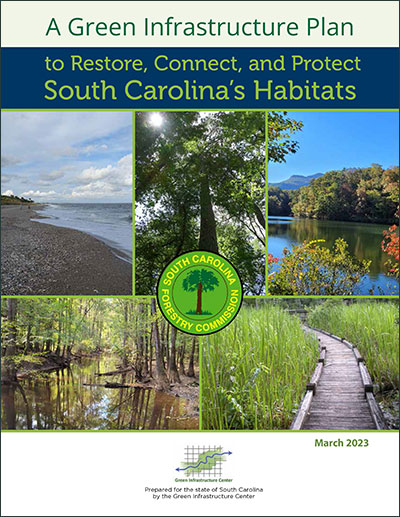Green Infrastructure Center, Inc.
GIC maps natural assets to create green infrastructure plans and green prints.

A Green Infrastructure Plan-SC
GIC built a statewide habitat model and maps all 10 planning regions. To stem the loss of South Carolina’s natural resources and to ensure that the landscape is resilient, the South Carolina Forest Commission and GIC launched a statewide strategic planning effort to map key, large habitat areas known as core habitats and to identify and plan for their connectivity. The more connected the landscape is, the more resilient it is to disturbance, since areas damaged by storms or floods can repopulate more quickly if species can reach these areas through natural landscape corridors.
The GIC created a statewide map of large forest and wetland habitats in 2015, as well as a guide Evaluating and Conserving Green Infrastructure Across the Landscape: A Practitioner’s Guide, which describes the importance of habitat cores and how to plan for their conservation. This report does not replace that guide. This project is an update to the original map and a strategic plan for actions and strategies that South Carolina can employ to conserve its highest value landscapes for both wildlife and people.
Since 2015, the landscape of South Carolina has changed as intact forested land cover has declined. In addition, more species are now at risk. For example, the U.S. Forest Service listed the Northern Long Eared bat as an endangered species in November 2022. This bat has mostly disappeared from the upstate but has been found in Charleston and Berkeley Counties, both of which are experiencing tremendous growth pressures, putting the bats at greater risk. To prioritize the landscapes to conserve for the future, GIC has created an updated statewide map of large habitat cores and connecting corridors and worked with local governments to select priority connections to ensure that abundant and diverse native species can be sustained in South Carolina.
Mapping intact habitat cores and their connecting corridors has many practical applications beyond providing habitat for birds, amphibians and wildlife. Corridors also facilitate recreation networks, such as greenways and blueways. Corridor planning can also meet goals for highway safety by identifying areas where there can be conflicts and devising other strategies, such as wildlife tunnels or bridges, and other tactics to reduce road/wildlife conflicts. Water quality is also protected, as key riparian corridors can be identified and either conserved or restored through tree planting and conservation projects. Also key to forestland conservation is the protection of those working landscapes that support the state’s timber industry, a network of forestry projects providing $23.2 billion to the state’s economy and the greatest number of jobs by sector.
To ensure that South Carolina’s natural landscape is resilient and that species can, not just survive, but thrive, we need to understand the quality, extent, and connectivity of that landscape. Many species depend on large intact habitats to survive and thrive. Without those intact landscapes, species lack enough area to support breeding populations. And habitat loss has repercussions for people’s health and safety too. South Carolinians need access to open, undeveloped land for their physical and mental well-being.
This effort to map the highest value landscapes in South Carolina was built from the ground up, region by region to result in a statewide priority network of vital conservation lands and corridors.
Green Infrastructure (GI) Plans can inform land-use decision makers about natural assets within their counties or regions, identify threats and help inform strategies for strategic land conservation. GI plans can be used to focus development into patterns that maximize resource conservation and economic efficiency, while also preserving a healthy economy. They can also be used to identify places to conserve for future parks and conservation easements, or as buffers.
Back to Resources